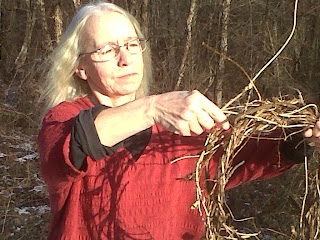 | ||||
| Fragrant herbs like lavender make a wonderful body powder. |
Herbal powders deodorize and heal
Herbal powders are easy to make, effective and have a relatively long shelf life. The base is simply pure arrowroot powder, kaolin or pascalite clay, rice powder, or a combination of the three. You will need ground or powdered herbs, which you can buy from any of the excellent online herb companies such as Mountain Rose Herbs, or powder them yourself with an herb/spice grinder. Ideally, you would use a mortar and pestle but for larger quantities such as my formulas, it would take a long time and a lot of effort. Also, sift the crushed herbs several times to make it as fine as possible.
You will also need containers. Any jar with a tight lid will work, although you can buy inexpensive, little powder dispensers from an herb shop. I used to sell my powders in the cardboard tube type because they more natural and bio-degradable than the all plastic ones.
Herbal powders are easy to make, effective and have a relatively long shelf life. The base is simply pure arrowroot powder, kaolin or pascalite clay, rice powder, or a combination of the three. You will need ground or powdered herbs, which you can buy from any of the excellent online herb companies such as Mountain Rose Herbs, or powder them yourself with an herb/spice grinder. Ideally, you would use a mortar and pestle but for larger quantities such as my formulas, it would take a long time and a lot of effort. Also, sift the crushed herbs several times to make it as fine as possible.
You will also need containers. Any jar with a tight lid will work, although you can buy inexpensive, little powder dispensers from an herb shop. I used to sell my powders in the cardboard tube type because they more natural and bio-degradable than the all plastic ones.
Deodorizing Herbal Powder not only smells wonderful but works fine as a mild body deodorant. This formula fills four large (3-oz) containers. Combine one cup of powdered lavender and patchouli. Mix with four ounces kaolin clay and four ounces arrowroot powder. Add the following essential oils (be sure to use pure essential oils and not synthetic fragrance oils, which have no medicinal value): 12 drops cedarwood, 6 drops lavender and 6 drops patchouli. Blend well and fill your jars.
Herbal Healing Powder has the gentle, soothing aroma and healing power of slippery elm bark. I was fortunate that a storm brought down a huge limb from a friend’s giant slippery elm tree. I harvested the cambium, or inner bark, and to this day I am still using my own supply. An organic herb company like Mountain Rose offers it as well. To four ounces of powdered slippery elm and calendula blossoms (which is an easy-to-grow annual flower), add four ounces kaolin clay and four ounces arrowroot powder. Blend well and fill three large (3-oz) shakers.
Please note that these powders may feel somewhat coarse compared to plain talc (even with repeated sifting). Although arrowroot, kaolin clay and rice powder are silky smooth, the powdered herbs, no matter how finely minced, will always add a slight rough feeling to the powder. The scent and effectiveness of the herbs, however, are well worth the minor difference.














